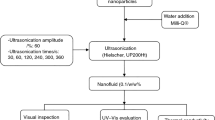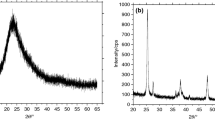Abstract
The objective of the present work is to analyze the consequences of the sonication period on the colloidal stability and thermal conductivity of SiO2–water nanofluid. Ultrasonication assisted two-step method was applied to prepare SiO2–water nanofluid at two different concentrations of 0.5 and 1 wt% without any surfactant. The sonication period varied from 1 to 3 h. Particle size was analysed by direct light scattering (DLS). Zeta potential analysis and light absorbance test were performed to check the colloidal stability of nanofluids. The thermal conductivity of nanofluid was measured over the temperature range of 25–60 °C. The obtained results indicate that increasing sonication time is crucial for the enhacement in stability and thermal conductivity of nanofluid. With increasing temperature, the thermal conductivity of nanofluids also increased. Moreover, at lower temperature, sonication plays a dominant role on thermal conductivity enhacement in nanofluids. The investigation concludes that a minimum 2.5 h of sonication is required for the better performance of nanofluids.










Similar content being viewed by others
Abbreviations
- N A :
-
Avogadro number, 6.023 × 1023 (per mol)
- k :
-
Thermal conductivity (W/mK)
- K B :
-
Boltzmann constant, 1.3807 × 10−23 \(\left( {\frac{J}{K}} \right)\)
- M :
-
Molar mass (kg/mole)
- V :
-
Molar volume (m3/mol)
- \(n\) :
-
Frequency (Hz)
- \(w\) :
-
Weight (kg)
- \(T\) :
-
Temperature (°C)
- \(U\) :
-
Uncertainity (%)
- \(\phi\) :
-
Weight concentration (%)
- \({\phi }_{v}\) :
-
Volume concentration (%)
- \(\lambda\) :
-
Wave length (m)
- \(\chi\) :
-
Mole fractions (−)
- \(\rho\) :
-
Density (kg/m3)
- bf:
-
Basefluid
- np:
-
Nanoparticles
- nf:
-
Nanofluid
References
S. K. Das, S. U. Choi, W. Yu, and T. Pradeep, Nanofluids: Science and Technology (John Wiley & Sons, 2007).
I. Mahbubul, I. Shahrul, S. Khaleduzzaman, R. Saidur, M. Amalina, and A. Turgut (2015). Experimental investigation on effect of ultrasonication duration on colloidal dispersion and thermophysical properties of alumina–water nanofluid. Int. J. Heat Mass Transf. 88, 73–81.
V. S. Nguyen, D. Rouxel, R. Hadji, B. Vincent, and Y. Fort (2011). Effect of ultrasonication and dispersion stability on the cluster size of alumina nanoscale particles in aqueous solutions. Ultrason. Sonochem. 18 (1), 382–388. https://doi.org/10.1016/j.ultsonch.2010.07.003.
R. A. Farade, N. I. A. Wahab, D.-E.A. Mansour, N. B. Azis, J. B. Jasni, V. Veerasamy, M. Thirumeni, A. X. R. Irudayaraj, and A. S. Murthy (2021). Investigation of the Effect of Sonication Time on Dispersion Stability, Dielectric Properties, and Heat Transfer of Graphene Based Green Nanofluids. IEEE Access 9, 50607–50623.
A. Afzal, I. Nawfal, I. M. Mahbubul, and S. S. Kumbar (2019). An overview on the effect of ultrasonication duration on different properties of nanofluids. J. Therm. Anal. Calorim. 135 (1), 393–418. https://doi.org/10.1007/s10973-018-7144-8.
R. Choudhary, D. Khurana, A. Kumar, and S. Subudhi (2017). Stability analysis of Al2O3/water nanofluids. J. Exp. Nanosci. 12 (1), 140–151. https://doi.org/10.1080/17458080.2017.1285445.
K. Kwak and C. Kim (2005). Viscosity and thermal conductivity of copper oxide nanofluid dispersed in ethylene glycol. Korea-Aust. Rheol. J. 17 (2), 35–40.
J.-H. Lee, K. S. Hwang, S. P. Jang, B. H. Lee, J. H. Kim, S. U. S. Choi, and C. J. Choi (2008). Effective viscosities and thermal conductivities of aqueous nanofluids containing low volume concentrations of Al2O3 nanoparticles. Int. J. Heat Mass Transf. 51 (11), 2651–2656. https://doi.org/10.1016/j.ijheatmasstransfer.2007.10.026.
P. Garg, J. L. Alvarado, C. Marsh, T. A. Carlson, D. A. Kessler, and K. Annamalai (2009). An experimental study on the effect of ultrasonication on viscosity and heat transfer performance of multi-wall carbon nanotube-based aqueous nanofluids. Int. J. Heat Mass Transf. 52 (21), 5090–5101. https://doi.org/10.1016/j.ijheatmasstransfer.2009.04.029.
H. Zhu, C. Li, D. Wu, C. Zhang, and Y. Yin (2010). Preparation, characterization, viscosity and thermal conductivity of CaCO3 aqueous nanofluids. Sci. China Technol. Sci. 53 (2), 360–368. https://doi.org/10.1007/s11431-010-0032-5.
J. Yu, N. Grossiord, C. E. Koning, and J. Loos (2007). Controlling the dispersion of multi-wall carbon nanotubes in aqueous surfactant solution. Carbon 45 (3), 618–623. https://doi.org/10.1016/j.carbon.2006.10.010.
M. E. Kabir, M. C. Saha, and S. Jeelani (2007). Effect of ultrasound sonication in carbon nanofibers/polyurethane foam composite. Mater. Sci. Eng.: A 459 (1), 111–116. https://doi.org/10.1016/j.msea.2007.01.031.
H. Yu, S. Hermann, S. E. Schulz, T. Gessner, Z. Dong, and W. J. Li (2012). Optimizing sonication parameters for dispersion of single-walled carbon nanotubes. Chem. Phys. 408, 11–16. https://doi.org/10.1016/j.chemphys.2012.08.020.
H. M. Ali (2020). Recent advancements in PV cooling and efficiency enhancement integrating phase change materials based systems – A comprehensive review. Sol. Energy 197, 163–198. https://doi.org/10.1016/j.solener.2019.11.075.
G. Sriharan, S. Harikrishnan, and H. M. Ali (2021). Experimental investigation on the effectiveness of MHTHS using different metal oxide-based nanofluids. J. Therm. Anal. Calorim. 143 (2), 1251–1260. https://doi.org/10.1007/s10973-020-09779-5.
H. A. Tariq, M. Anwar, A. Malik, and H. M. Ali (2020). Hydro-thermal performance of normal-channel facile heat sink using TiO2-H2O mixture (Rutile–Anatase) nanofluids for microprocessor cooling. J. Therm. Anal. Calorim.. https://doi.org/10.1007/s10973-020-09838-x.
M. Ghaneifar, A. Raisi, H. M. Ali, and P. Talebizadehsardari (2021). Mixed convection heat transfer of AL2O3 nanofluid in a horizontal channel subjected with two heat sources. J. Therm. Anal. Calorim. 143 (3), 2761–2774. https://doi.org/10.1007/s10973-020-09887-2.
A. A. Ahmadi, M. Arabbeiki, H. M. Ali, M. Goodarzi, and M. R. Safaei (2020). Configuration and optimization of a minichannel using water–alumina nanofluid by non-dominated sorting genetic algorithm and response surface method. Nanomaterials 10 (5). https://doi.org/10.3390/nano10050901.
Z. Chen, A. Shahsavar, A. A. A. A. Al-Rashed, and M. Afrand (2020). The impact of sonication and stirring durations on the thermal conductivity of alumina-liquid paraffin nanofluid: an experimental assessment. Powder Technol. 360, 1134–1142.
A. Asadi, F. Pourfattah, I. M. Szilágyi, M. Afrand, G. Żyła, H. S. Ahn, S. Wongwises, H. M. Nguyen, A. Arabkoohsar, and O. Mahian (2019). Effect of sonication characteristics on stability, thermophysical properties, and heat transfer of nanofluids: A comprehensive review. Ultrason. Sonochem. 58, 104701.
Y. Li, R. Kalbasi, Q. Nguyen, and M. Afrand (2020). Effects of sonication duration and nanoparticles concentration on thermal conductivity of silica-ethylene glycol nanofluid under different temperatures: an experimental study. Powder Technol. 367, 464–473.
M. Kole and T. K. Dey (2012). Effect of prolonged ultrasonication on the thermal conductivity of ZnO–ethylene glycol nanofluids. Thermochim. Acta 535, 58–65. https://doi.org/10.1016/j.tca.2012.02.016.
A. Amrollahi, A. A. Hamidi, and A. M. Rashidi (2008). The effects of temperature, volume fraction and vibration time on the thermo-physical properties of a carbon nanotube suspension (carbon nanofluid). Nanotechnology 19 (31), 315701. https://doi.org/10.1088/0957-4484/19/31/315701.
B. Buonomo, O. Manca, L. Marinelli, and S. Nardini (2015). Effect of temperature and sonication time on nanofluid thermal conductivity measurements by nano-flash method. Appl. Therm. Eng. 91, 181–190.
S. Mukherjee, P. C. Mishra, and P. Chaudhuri (2018). Stability of Heat Transfer Nanofluids – A Review. ChemBioEng Rev. 5 (5), 312–333. https://doi.org/10.1002/cben.201800008.
Y. Hwang, J.-K. Lee, J.-K. Lee, Y.-M. Jeong, S.-i Cheong, Y.-C. Ahn, and S. H. Kim (2008). Production and dispersion stability of nanoparticles in nanofluids. Powder Technol. 186 (2), 145–153. https://doi.org/10.1016/j.powtec.2007.11.020.
R. M. Mostafizur, R. Saidur, A. R. A. Aziz, and M. H. U. Bhuiyan, Investigation on stability and density of methanol based TiO2 nanofluids. In, 2015 (IOP Publishing), p. 012057.
M. Nabeel Rashin and J. Hemalatha (2014). A novel ultrasonic approach to determine thermal conductivity in CuO-ethylene glycol nanofluids. J. Mol. Liq. 197, 257–262. https://doi.org/10.1016/j.molliq.2014.05.024.
WebBook N (2016). Thermophysical properties of fluid systems. Avaliable Online: http://webbook.nist.gov/chemistry/fluid/. (access on 18 January 2015).
R. Sadeghi, S. G. Etemad, E. Keshavarzi, and M. Haghshenasfard (2015). Investigation of alumina nanofluid stability by UV–vis spectrum. Microfluid. Nanofluid. 18 (5), 1023–1030. https://doi.org/10.1007/s10404-014-1491-y.
J. Shah, M. Ranjan, V. Davariya, S. K. Gupta, and Y. Sonvane (2017). Temperature-dependent thermal conductivity and viscosity of synthesized α-alumina nanofluids. Appl. Nanosci. 7 (8), 803–813. https://doi.org/10.1007/s13204-017-0594-7.
M. Kılıç, M. Yavuz, and İH. Yılmaz (2018). Numerical investigation of combined effect of nanofluids and impinging jets on heated surface. Int. Adv. Res. Eng. J. 2 (1), 14–19.
Acknowledgements
The authors cordially acknowledge the financial support provided by DAE-BRNS for their financial support. We are also thankful to the School of Mechanical Engineering, KIIT Deemed to be University for supporting us to carry out the research work.
Funding
Funding was provided by Board of Research in Nuclear Sciences (Grant No. 39/14/04/2017-BRNS/34301).
Author information
Authors and Affiliations
Corresponding author
Ethics declarations
Conflict of interest
The authors do not share any conflicts of interest.
Additional information
Publisher's Note
Springer Nature remains neutral with regard to jurisdictional claims in published maps and institutional affiliations.
Rights and permissions
About this article
Cite this article
Mukherjee, S., Mishra, P.C., Chakrabarty, S. et al. Effects of Sonication Period on Colloidal Stability and Thermal Conductivity of SiO2–Water Nanofluid: An Experimental Investigation. J Clust Sci 33, 1763–1771 (2022). https://doi.org/10.1007/s10876-021-02100-w
Received:
Accepted:
Published:
Issue Date:
DOI: https://doi.org/10.1007/s10876-021-02100-w




